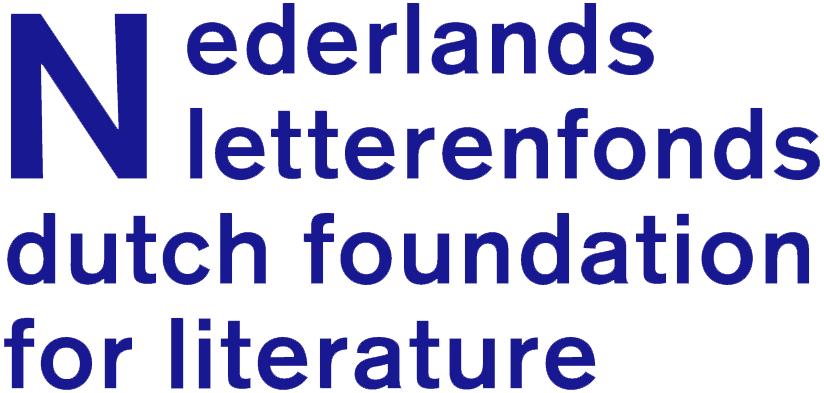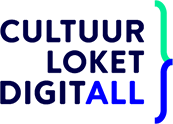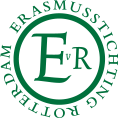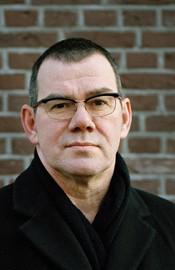Gedicht
Jan Baeke
TAXONOMY
It took a long time to finish.All summer long, in defiance of the heat, we tidied up the classification tables
took new cuttings and guided them towards the cool morning
where we fell into each other’s arms, exhausted but satisfied.
Freed from the tables briefly, not quite knowing how to interpret the limbs
we’d used to support the desks and display cases.
It’s taken yet another day. Autumn has overtaken us.
I’d hung the figures up to dry, taking advantage of the gentle east wind.
You’d called out from our work room ‘make sure the wind won’t blow it all away’.
Uncertain of the outcome, I too sensed that vulnerability.
No one cares, someone else will take over the tables and make a splash.
We are being accused of undermining the established order, the authority of institutions
‘with your shaky theories you’re destroying our whole society.’
These thoughts scared me, I tried to comfort myself with television, but couldn’t find a single programme that brought relief.
It was then that I realised the tables wanted more, they had something to add.
The first thing I wrote down was:
Something is added that doesn’t exist yet. What shape will it take?
The rudimentary shape disturbs the other plant species in the scheme, but they understand the symbolism.
A plant is a palm, an olive tree, a rose of Jericho, a bramble
see the frameworks on pages 14 to 68.
A man enters a flower shop and sees that the wife of the florist resembles his mother. His mother is an image that he instinctively places on the left-hand side.
On the left-hand side of the page, the habits of the plants. On the right, the tables.
An attempt at explaining something about tables.
Table A.
It’s a mistake to think that the explanation will linger in our minds
as in a poem
that conjures up a florist in a small flower shop
in conversation with a customer
and around them a cloud of suggestions that rise above the conversation
and reach the florist’s wife
turning the wife into an image that men push forward
so they can get the better of each other and drown in that image.
Table B.
It’s a mistake to think that the explanation will linger in our minds
as in a photo, for instance,
that depicts the researcher busy trying to get his tables right
just when a woman casts a quick glance through the window
while continuing to chat with a friend
It’s like when we sum up what moves us and what hurts us.
In the people we describe so casually
because we want to explain what’s okay and what isn’t
before we lose all interest.
We do lose all interest. It’s hot. Our bodies are bothering us.
A great tiredness sits in our joints.
Something has happened and the florist doesn’t recognise its silhouette. His wife has forgotten how to speak. The shop needs to close for an investigation, but anyone who wants flowers can drop by in the evening or arrange to meet at the café on the Plaza Mayor.
Tomorrow qualified officials will draw silhouettes on the asphalt in white chalk.
Figure 5. The fingers of a Rudbeckia
Figure 6. The fingers of a date palm
Figure 7. The number of arrests in the past ten years.
We had shut the windows on time, stored the tables in the drawers of our new desk.
‘What was it all about, that business with the florist?’ I heard you say and I showed you the newspaper cuttings.
It’s like that broadcast last week that we didn’t listen to
and like what you keep next to your tables
the letters that so desired you, the boy that would replace me when I leave for Lapland next week to paint new ramifications.
At the back of the studio, where we keep the larger cutters and shovels, lie my reasons for forgetting Mrs. Caddy, and that’s where we also keep the small boxes with the money I made on the tables. It wasn’t a reality yet, but already there was the thought of the drunken afternoon that would take ten years to materialise – the way life had been a sheet of ice between a hard-working taxonomist and a later happiness, the silence and the warmth found in the lap of Sara Lisa Moraea.
TAXONOMIE
TAXONOMIE
Het heeft lang geduurd voor het klaar was.De hele zomer door, tegen de warmte in, de tabellen opgeknapt
opnieuw gestekt en naar de koele ochtend geleid
waar we elkaar moe maar voldaan in de armen vielen.
Even van de tabellen verlost, niet goed wetend hoe we de ledematen
moeten interpreteren waarmee we de lessenaars en de vitrinekasten gestut hebben.
Het duurt alweer een dag langer. De herfst heeft ons ingehaald.
Ik had de getallen te drogen gehangen, profiterend van de zachte oostenwind.
Jij riep nog vanuit onze werkvertrekken ‘let op, dat de wind er geen vat op krijgt’.
Onzeker over de uitkomst, ook ik voelde de kwetsbaarheid.
Het interesseert niemand, een ander neemt de tabellen over en maakt furore.
Er wordt ons verweten de orde te ondermijnen, het gezag van instituties
‘met jullie wankele theorieën maak je de hele maatschappij kapot.’
Ik schrok van deze gedachten, zocht troost bij de televisie, maar zag geen programma
dat mijn hart verlichtte.
Juist toen wist ik dat de tabellen meer wilden, dat ze iets hadden toe te voegen.
Als eerste schreef ik op:
Er komt iets bij, dat nog niet bestaat.
Welke vorm mogen we verwachten?
De onuitgewerkte vorm verontrust de andere plantensoorten in het schema
maar ze begrijpen de symboliek.
Een plant is een palm, een olijfboom, een roos van Jericho, een braambos
en het kader staat op bladzijden 14 tot en met 68.
Een man komt een bloemenwinkel binnen en ziet hoe de vrouw van de bloemist
op zijn moeder lijkt. Zijn moeder is dat beeld
dat hij onwillekeurig links plaatst.
Links op het blad, de verschijningsvormen. Rechts de tabellen.
Een poging om iets te verklaren over tabellen.
Tabel A.
Het is een vergissing te denken dat de uitleg ons bij zal blijven
zoals bijvoorbeeld in een gedicht
dat een bloemist oproept in een klein bloemenzaakje
in gesprek met een koper
en daar omheen een wolk suggesties die boven het gesprek uitstijgen
en de vrouw van de bloemist bereiken
van de vrouw een beeld maken dat de mannen naar voren schuiven
om het van elkaar te winnen en in het beeld ten onder te gaan.
Tabel B.
Het is een vergissing te denken dat de uitleg ons bij zal blijven
zoals bijvoorbeeld op een foto
die de onderzoeker afbeeldt druk bezig om zijn tabellen sluitend te krijgen
terwijl een vrouw door het raam een blik naar binnen werpt
maar in gesprek blijft met een vriendin
die dezelfde tactiek volgt.
Het is zoals we opsommen wat ons ontroert en kwetst.
In de mensen die we zo achteloos beschrijven
omdat we willen vertellen wat er wel en niet deugt
voordat we alle interesse verliezen.
We verliezen elke interesse. Het is warm. We hebben last van onze lichamen.
Een grote vermoeidheid hangt in onze gewrichten.
Er is iets gebeurd waar de bloemist het silhouet niet van herkent. Zijn vrouw is het spreken verleerd. De winkel moet dicht voor onderzoek, maar wie bloemen wil, kan ’s avonds langs komen of afspreken in het café aan de Plaza Mayor.
Morgen tekenen bevoegde functionarissen silhouetten op het asfalt met wit krijt.
Figuur 5. De vingers van een Rudbeckia
Figuur 6. De vingers van een dadelpalm
Figuur 7. Het aantal arrestaties van de laatste tien jaar.
We deden de ramen op tijd dicht, borgen de tabellen op in de lades van ons nieuwe bureau.
‘Wat was dat nou, met die bloemist?’ hoorde ik je zeggen en ik liet je de knipsels zien.
Net als waar we niet naar hebben geluisterd, die uitzending van verleden week
en wat jij naast jouw tabellen bewaart
de brieven die jou zo begeerden, de jongen die mij zou vervangen als ik volgende week in Lapland nieuwe vertakkingen ga schilderen.
Achter in het atelier waar we de grotere tangen en schoppen bewaren, liggen mijn argumenten om Mrs Caddy te vergeten, daar staan ook de kleine dozen met het geld dat ik uit de tabellen haalde. Nog niet de werkelijkheid, maar wel de gedachte aan de dronken middag die nog tien jaar op zich zou laten wachten, zoals de wereld ijs bleef tussen een hardwerkende taxonomist en het latere geluk, het zwijgen en de warmte in de schoot van Sara Lisa Moraea.
Gedichten
Gedichten van Jan Baeke
Close
TAXONOMIE
Het heeft lang geduurd voor het klaar was.De hele zomer door, tegen de warmte in, de tabellen opgeknapt
opnieuw gestekt en naar de koele ochtend geleid
waar we elkaar moe maar voldaan in de armen vielen.
Even van de tabellen verlost, niet goed wetend hoe we de ledematen
moeten interpreteren waarmee we de lessenaars en de vitrinekasten gestut hebben.
Het duurt alweer een dag langer. De herfst heeft ons ingehaald.
Ik had de getallen te drogen gehangen, profiterend van de zachte oostenwind.
Jij riep nog vanuit onze werkvertrekken ‘let op, dat de wind er geen vat op krijgt’.
Onzeker over de uitkomst, ook ik voelde de kwetsbaarheid.
Het interesseert niemand, een ander neemt de tabellen over en maakt furore.
Er wordt ons verweten de orde te ondermijnen, het gezag van instituties
‘met jullie wankele theorieën maak je de hele maatschappij kapot.’
Ik schrok van deze gedachten, zocht troost bij de televisie, maar zag geen programma
dat mijn hart verlichtte.
Juist toen wist ik dat de tabellen meer wilden, dat ze iets hadden toe te voegen.
Als eerste schreef ik op:
Er komt iets bij, dat nog niet bestaat.
Welke vorm mogen we verwachten?
De onuitgewerkte vorm verontrust de andere plantensoorten in het schema
maar ze begrijpen de symboliek.
Een plant is een palm, een olijfboom, een roos van Jericho, een braambos
en het kader staat op bladzijden 14 tot en met 68.
Een man komt een bloemenwinkel binnen en ziet hoe de vrouw van de bloemist
op zijn moeder lijkt. Zijn moeder is dat beeld
dat hij onwillekeurig links plaatst.
Links op het blad, de verschijningsvormen. Rechts de tabellen.
Een poging om iets te verklaren over tabellen.
Tabel A.
Het is een vergissing te denken dat de uitleg ons bij zal blijven
zoals bijvoorbeeld in een gedicht
dat een bloemist oproept in een klein bloemenzaakje
in gesprek met een koper
en daar omheen een wolk suggesties die boven het gesprek uitstijgen
en de vrouw van de bloemist bereiken
van de vrouw een beeld maken dat de mannen naar voren schuiven
om het van elkaar te winnen en in het beeld ten onder te gaan.
Tabel B.
Het is een vergissing te denken dat de uitleg ons bij zal blijven
zoals bijvoorbeeld op een foto
die de onderzoeker afbeeldt druk bezig om zijn tabellen sluitend te krijgen
terwijl een vrouw door het raam een blik naar binnen werpt
maar in gesprek blijft met een vriendin
die dezelfde tactiek volgt.
Het is zoals we opsommen wat ons ontroert en kwetst.
In de mensen die we zo achteloos beschrijven
omdat we willen vertellen wat er wel en niet deugt
voordat we alle interesse verliezen.
We verliezen elke interesse. Het is warm. We hebben last van onze lichamen.
Een grote vermoeidheid hangt in onze gewrichten.
Er is iets gebeurd waar de bloemist het silhouet niet van herkent. Zijn vrouw is het spreken verleerd. De winkel moet dicht voor onderzoek, maar wie bloemen wil, kan ’s avonds langs komen of afspreken in het café aan de Plaza Mayor.
Morgen tekenen bevoegde functionarissen silhouetten op het asfalt met wit krijt.
Figuur 5. De vingers van een Rudbeckia
Figuur 6. De vingers van een dadelpalm
Figuur 7. Het aantal arrestaties van de laatste tien jaar.
We deden de ramen op tijd dicht, borgen de tabellen op in de lades van ons nieuwe bureau.
‘Wat was dat nou, met die bloemist?’ hoorde ik je zeggen en ik liet je de knipsels zien.
Net als waar we niet naar hebben geluisterd, die uitzending van verleden week
en wat jij naast jouw tabellen bewaart
de brieven die jou zo begeerden, de jongen die mij zou vervangen als ik volgende week in Lapland nieuwe vertakkingen ga schilderen.
Achter in het atelier waar we de grotere tangen en schoppen bewaren, liggen mijn argumenten om Mrs Caddy te vergeten, daar staan ook de kleine dozen met het geld dat ik uit de tabellen haalde. Nog niet de werkelijkheid, maar wel de gedachte aan de dronken middag die nog tien jaar op zich zou laten wachten, zoals de wereld ijs bleef tussen een hardwerkende taxonomist en het latere geluk, het zwijgen en de warmte in de schoot van Sara Lisa Moraea.
TAXONOMY
It took a long time to finish.All summer long, in defiance of the heat, we tidied up the classification tables
took new cuttings and guided them towards the cool morning
where we fell into each other’s arms, exhausted but satisfied.
Freed from the tables briefly, not quite knowing how to interpret the limbs
we’d used to support the desks and display cases.
It’s taken yet another day. Autumn has overtaken us.
I’d hung the figures up to dry, taking advantage of the gentle east wind.
You’d called out from our work room ‘make sure the wind won’t blow it all away’.
Uncertain of the outcome, I too sensed that vulnerability.
No one cares, someone else will take over the tables and make a splash.
We are being accused of undermining the established order, the authority of institutions
‘with your shaky theories you’re destroying our whole society.’
These thoughts scared me, I tried to comfort myself with television, but couldn’t find a single programme that brought relief.
It was then that I realised the tables wanted more, they had something to add.
The first thing I wrote down was:
Something is added that doesn’t exist yet. What shape will it take?
The rudimentary shape disturbs the other plant species in the scheme, but they understand the symbolism.
A plant is a palm, an olive tree, a rose of Jericho, a bramble
see the frameworks on pages 14 to 68.
A man enters a flower shop and sees that the wife of the florist resembles his mother. His mother is an image that he instinctively places on the left-hand side.
On the left-hand side of the page, the habits of the plants. On the right, the tables.
An attempt at explaining something about tables.
Table A.
It’s a mistake to think that the explanation will linger in our minds
as in a poem
that conjures up a florist in a small flower shop
in conversation with a customer
and around them a cloud of suggestions that rise above the conversation
and reach the florist’s wife
turning the wife into an image that men push forward
so they can get the better of each other and drown in that image.
Table B.
It’s a mistake to think that the explanation will linger in our minds
as in a photo, for instance,
that depicts the researcher busy trying to get his tables right
just when a woman casts a quick glance through the window
while continuing to chat with a friend
It’s like when we sum up what moves us and what hurts us.
In the people we describe so casually
because we want to explain what’s okay and what isn’t
before we lose all interest.
We do lose all interest. It’s hot. Our bodies are bothering us.
A great tiredness sits in our joints.
Something has happened and the florist doesn’t recognise its silhouette. His wife has forgotten how to speak. The shop needs to close for an investigation, but anyone who wants flowers can drop by in the evening or arrange to meet at the café on the Plaza Mayor.
Tomorrow qualified officials will draw silhouettes on the asphalt in white chalk.
Figure 5. The fingers of a Rudbeckia
Figure 6. The fingers of a date palm
Figure 7. The number of arrests in the past ten years.
We had shut the windows on time, stored the tables in the drawers of our new desk.
‘What was it all about, that business with the florist?’ I heard you say and I showed you the newspaper cuttings.
It’s like that broadcast last week that we didn’t listen to
and like what you keep next to your tables
the letters that so desired you, the boy that would replace me when I leave for Lapland next week to paint new ramifications.
At the back of the studio, where we keep the larger cutters and shovels, lie my reasons for forgetting Mrs. Caddy, and that’s where we also keep the small boxes with the money I made on the tables. It wasn’t a reality yet, but already there was the thought of the drunken afternoon that would take ten years to materialise – the way life had been a sheet of ice between a hard-working taxonomist and a later happiness, the silence and the warmth found in the lap of Sara Lisa Moraea.
Sponsors

























